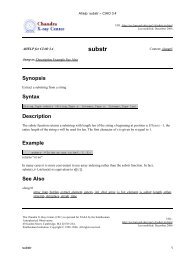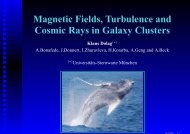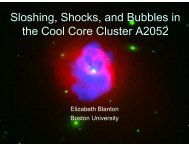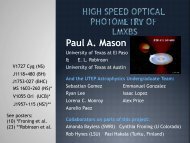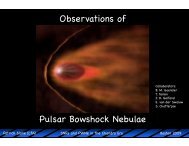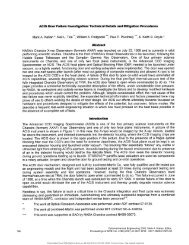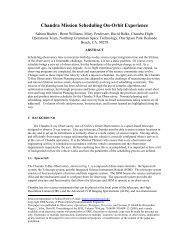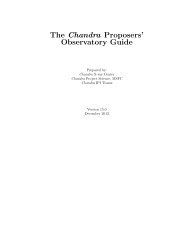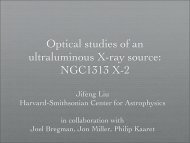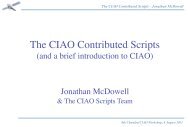PDF Version - Chandra X-Ray Observatory (CXC)
PDF Version - Chandra X-Ray Observatory (CXC)
PDF Version - Chandra X-Ray Observatory (CXC)
Create successful ePaper yourself
Turn your PDF publications into a flip-book with our unique Google optimized e-Paper software.
32<br />
Fig. 2 - First page of a 29 page musical score corresponding to<br />
the sonification of the FFT of the <strong>Chandra</strong> X-ray lightcurve<br />
of EX-Hya.<br />
67-minute oscillation is believed to be the spin period<br />
of the white dwarf component. A long (~500 ks) <strong>Chandra</strong><br />
observation of EX Hya was obtained with HETG and<br />
ACIS-S. We sonified the EX Hydra X-ray light curve in<br />
pitch mode, normalized to a musical scale, to analyze its<br />
frequency content. Temporal fluctuation information is<br />
portrayed as simultaneously sounded clusters of pitches.<br />
Phase, frequency and time variations as a function of pitch<br />
can be grouped and then extracted from the data. Persistent<br />
or intermittent features in the data may map to interesting<br />
physical parameters of the EX Hya system. Given<br />
the human ability to transform the disturbance reaching<br />
our ears from the space domain to the frequency domain,<br />
this step may be compared to decomposing the data into<br />
different simple modes of oscillation.<br />
We listened to the FFT data, binned into segments<br />
of 10 min each. The frequency information was<br />
represented as musical notes readily familiar to the ear,<br />
and the spin period is easily recovered. A period search<br />
performed by extracting the harmonics showed several<br />
statistically significant periods in the range between 250<br />
and 800 sec.<br />
Perception Experiment<br />
We recently completed perception experiments to<br />
investigate the effectiveness of sonification together with<br />
visual display for compare event detection in the data as<br />
compared to visual display only. A second aim of these<br />
experiments was to investigate whether sonification enhances<br />
data analysis. These rigorous laboratory experiments<br />
on attention control, and human-computer interaction<br />
(HCI), will help identify how combining sonification<br />
<strong>CXC</strong> Newsletter<br />
with visualization can enhance scientific data analysis.<br />
If new efficiencies or new capabilities are identified, our<br />
study seeks to understand how to build on these through<br />
training.<br />
The perception experiments include empirical<br />
measurement of performance. Here, double-peaked radio-frequency<br />
spectra of water maser emission observed<br />
in the corners of active galactic nuclei were simulated by a<br />
pair of gaussians displayed on the screen, over which random<br />
noise was superimposed. Participants were presented<br />
simulated spectra and asked to identify the presence<br />
of a “signal” obscured by noise, at varying signal-to-noise<br />
ratios. Test volunteers experience astronomy data via audio<br />
cues, visual cues, both together, and also both cues<br />
with a sweep line. The volunteers responded to the cues<br />
using the keyboard, and their threshold for detection was<br />
estimated using an algorithm called QUEST (Quick Unbiased<br />
and Efficient Statistical Tree). We hope our results<br />
will bring a more diverse community into data analysis<br />
and will open up a multimodal approach to scientific data.<br />
Acknowledgments<br />
This work has been supported by the Smithsonian<br />
Women’s Committee, the George E. Burch Foundation<br />
Fellowship at the Smithsonian, and the Laboratory for Visual<br />
Learning at the Science Education Department at the<br />
Harvard-Smithsonian Center for Astrophysics .<br />
Fig. 3 - Our experiments simulated the double-peaked H 2 O<br />
emission profiles from active galactic nuclei, here from (a)<br />
NGC 3393 and (b) NGC 591. A double gaussian was used to<br />
simulate the emission peaks, and random noise was added. The<br />
experiments measured the signal-to-noise threshold at which<br />
participants were able to reliably detect the “signal” in the presence<br />
of noise. The experiment compared response sensitivity<br />
in visual presentations, auditory presentations, and combined<br />
visual and auditory presentations to gauge the efficacy of sonification<br />
for promoting detection.



